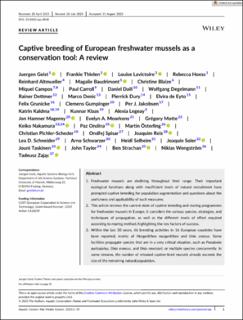Captive breeding of European freshwater mussels as aconservation tool: A review
Geist, Juergen; Thielen, Frankie; Lavictoire, Louise; Hoess, Rebecca; Altmueller, Reinhard; Baudrimont, Magalie; Blaize, Christine; Campos, Miquel; Carrol, Paul; Daill, Daniel; Degelmann, Wolfgang; Dettmer, Rainer; Denic, Marco; Dury, Pierrick; de Eyto, Elvira; Grunicke, Felix; Gumpinger, Clemens; Jakobsen, Per J.; Kaldma, Katrin; Klaas, Kunnar; Legeay, Alexia; Magerøy, Jon Hamner; Moorkens, Evelyn A.; Motte, Gregory; Nakamura, Keiko; Ondina, Paz; Österling, Martin; Pichler-Scheder, Christian; Spisar, Ondrej; Reis, Joaquim; Schneider, Lea D.; Schwarzer, Arno; Selheim, Heidi; Soler, Joaquín; Taskinen, Jouni; Taylor, John; Strachan, Ben; Wengstrom, Niklas; Zając, Tadeusz
Journal article, Peer reviewed
Published version

Åpne
Permanent lenke
https://hdl.handle.net/11250/3092640Utgivelsesdato
2023Metadata
Vis full innførselSamlinger
- Department of Biological Sciences [2232]
- Registrations from Cristin [9766]
Sammendrag
1. Freshwater mussels are declining throughout their range. Their importantecological functions along with insufficient levels of natural recruitment haveprompted captive breeding for population augmentation and questions about the usefulness and applicability of such measures.
2. This article reviews the current state of captive breeding and rearing programmes for freshwater mussels in Europe. It considers the various species, strategies, andtechniques of propagation, as well as the different levels of effort requiredaccording to rearing method, highlighting the key factors of success.
3. Within the last 30 years, 46 breeding activities in 16 European countries have been reported, mainly of Margaritifera margaritifera and Unio crassus. Some facilities propagate species that are in a very critical situation, such as Pseudunio auricularius, Unio mancus, and Unio ravoisieri, or multiple species concurrently. Insome streams, the number of released captive-bred mussels already exceeds the size of the remaining natural population.
4. Rearing efforts range from highly intensive laboratory incubation to lowerintensity methods using in-river mussel cages or silos. Most breeding efforts are funded by national and EU LIFE(+) grants, are well documented, and consider the genetic integrity of the propagated mussels. Limited long-term funding perspectives, the availability of experienced staff, water quality, and feeding/survival during early life stages are seen as the most important challenges.
5. Successful captive breeding programmes need to be combined with restoration ofthe habitats into which the mussels are released. This work will benefit from anevidence-based approach, knowledge exchange among facilities, and an overall breeding strategy comprising multiple countries and conservation units.
